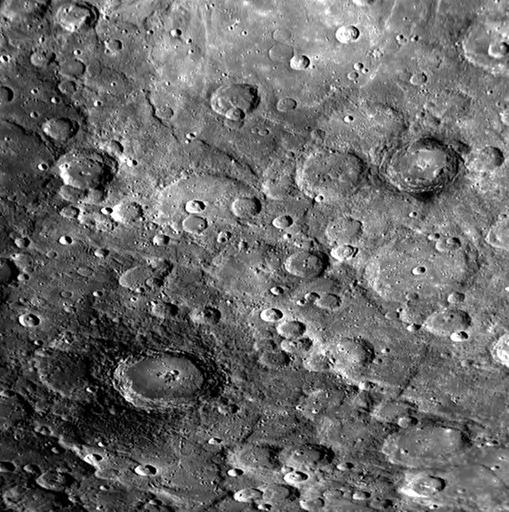
home •
about •
essential guide •
picture of the day •
thunderblogs •
news •
multimedia •
predictions •
products •
get involved •
contact
picture of the day archive subject index
Multiple craters with dark haloes. Credit: NASA/JPL/Northwestern University
Jul 31, 2008
More from MercuryThe latest images by the MESSENGER spacecraft indicate how similar Mercury is to other bodies in the solar system that have been scarred by electric arcs.
On August 3, 2004, NASA launched the Mercury Surface, Space Environment, Geochemistry and Ranging (MESSENGER) experiment from the Cape Canaveral facility on a 7-year mission to study the solar system’s innermost planet. On January 14, 2008, MESSENGER performed an initial flyby of Mercury, coming within 200 kilometers of the torrid world.
Since interplanetary probes are designed with power conservation in mind, they use a highly compressed stream of data, which takes time to decode. Some of the images are as late as February 27, 2008, with more coming. Once the spacecraft settles into orbit around its target world, a long-term study of Mercury’s plasmasphere, its magnetic field and its surface materials will begin.
Meanwhile, the geology of Mercury is intriguing to space scientists because it provides them with a number of “mysteries” and “processes that have yet to be understood.” Complex chains of craters and melted pits extend outward from terraced depressions over 60 kilometers wide. The flat bottoms and the vertical sidewalls have been presented in past Picture of the Day articles as signs that they were created through electric discharge machining (EDM) and not because of meteor impacts on the surface.
Although large pieces of rock impacting the surface of Mercury is not an unreasonable theory, the signs of EDM are more prevalent than the signs of kinetic shock through the strata. Most of the debris on the surface of Mercury appears to be chunks of fallback material that was blown out by the explosive energies of plasma discharges. Ordinarily, as in the image at the top of the page, the craters have little if any ejecta surrounding them. The crater field shown above is generally lacking in boulders or smaller breccias despite the surrounding haloes of blackened terrain.
Indeed, a close examination of some of those concentrations of craters reveals them to be woven together in patterns that criss-cross and braid themselves over and under one another. They all lie along the path of flat-topped mesas that rise above deep chasms cutting across the landscape without regard to the elevation. Many times the chasms slice right through the middle of a crater and its central mountain peak as if they weren’t even there.
Giant escarpments rise above V-shaped canyons and continue their way along the mountain tops and hundred-kilometer ridges that hulk around the planet. The long cliffs of Mercury are a feature that can also be found on Saturn’s moon Dione. Whether it is on Dione, Mercury, Ganymede, Mars or Venus – whenever we send satellites or rovers to examine the geology of other celestial objects, more and more evidence mounts in support of the Electric Universe and the electric discharges that have shaped the surfaces of solid bodies.
Mercury’s magnetic field is another enigma for NASA investigators. It is believed that Mercury generates a magnetic field in the same way as the Earth does, through a rotating “dynamo” at the core of the planet. Mercury is unique in that it has such a weak field for the size of its core – less that 1% as strong as Earth’s magnetic field. One theory is that Mercury has a solid outer shell that prevents the core from turning freely, thus reducing its momentum transfer into electromagnetism.
Another theory suggests that Mercury’s slow rotation keeps the magnetic field in a weakened state. Mercury rotates in 59 Earth days, making it the planet with the slowest rotation next to Venus. It is more likely that the problematic 'dynamo' theory of planetary magnetism is wrong.' A charged, slowly rotating body will produce a weak dipole magnetic field
By Stephen Smith
__________________________________________________________________Please visit our new "Thunderblog" page
Through the initiative of managing editor Dave Smith, we’ve begun the launch of a new
page called Thunderblog. Timely presentations of fact and opinion, with emphasis on
new discoveries and the explanatory power of the Electric Universe."The Electric Sky and The Electric Universe available now!

|
|

|
EXECUTIVE EDITORS:
David Talbott, Wallace Thornhill
MANAGING EDITORS:
Steve Smith, Mel Acheson
CONTRIBUTING EDITORS: Michael Armstrong, Dwardu Cardona,
Ev Cochrane,
C.J. Ransom, Don Scott, Rens van der Sluijs, Ian Tresman
WEBMASTER: Brian Talbott
Copyright 2007: thunderbolts.info
![]()
home •
thunderblogs •
forum •
picture of the day •
resources •
team •
updates •
contact us

